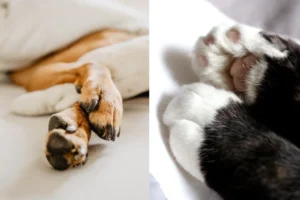Cats are fascinating creatures, possessing a range of unique characteristics that set them apart from other animals. One such curious feature is their carpal pads, small paw pads located on the underside of their wrists. Have you ever wondered why cats have these distinctive pads? In this blog post, we will explore the purpose of carpal pads in cats and delve into the intriguing reasons behind their presence.
Answer: Carpal pads in cats serve as shock absorbers and provide extra traction.
Evolutionary Advantage of Carpal Pads
Cats’ carpal pads, also known as “stopper pads,” have evolved over time to provide them with several unique advantages. One of the main reasons cats have carpal pads is to help with traction while climbing or running. These specialized pads on their front paws act as a kind of natural non-slip grip, allowing cats to navigate various terrains with ease.
Additionally, carpal pads play a crucial role in a cat’s stealth and hunting abilities. When stalking prey or maneuvering in tight spaces, these pads provide extra stability and agility, enabling cats to make quick and precise movements without slipping. This evolutionary trait has been honed over generations, giving cats a significant advantage in their natural environment.
Moreover, carpal pads also serve as a form of protection for a cat’s delicate paw pads. By providing an extra layer of cushioning and support, these pads help reduce impact and strain on the joints and tissues in their paws, especially during high-intensity activities like jumping or pouncing. This added support contributes to a cat’s overall agility and flexibility, making them formidable predators in the wild.
In essence, the evolutionary advantage of carpal pads lies in their multifunctionality, providing cats with enhanced grip, agility, and protection for their paws, ultimately contributing to their survival and success as hunters in the animal kingdom.
Functionality of Carpal Pads
Cats’ carpal pads are not only essential for their survival in the wild but also play a vital role in their daily activities and movements. These specialized pads, located on the underside of their front paws, are designed to help cats maintain balance and stability in various situations.
When a cat is walking, climbing, or jumping, the carpal pads come into contact with surfaces to provide added traction and grip. This not only helps prevent slipping but also enables cats to exert more force and control over their movements, especially when navigating challenging terrain or surfaces.
Moreover, carpal pads act as shock absorbers, cushioning the impact on their joints and bones when landing from a height or jumping down from elevated surfaces. This additional support helps prevent injuries and reduces strain on their limbs, allowing cats to move with agility and grace.
Furthermore, carpal pads aid in grooming and self-care routines by providing a secure footing for cats to balance on while they clean their fur or claws. This functionality is crucial for maintaining their hygiene and overall well-being, showcasing the versatility and importance of these specialized pads in a cat’s daily life.
In conclusion, the functionality of carpal pads extends beyond physical support, offering cats enhanced balance, stability, and protection in their daily activities, highlighting the crucial role these pads play in a cat’s overall health and behavior.
Comparison to Other Animals
Cats are not the only animals equipped with carpal pads; in fact, several other species possess similar structures. However, what sets felines apart is the unique functionality of these pads. While in dogs, carpal pads primarily serve as shock absorbers, in cats, they provide essential traction and support during climbing and hunting activities. This specificity in function showcases the intricate adaptation of feline anatomy to their agile and predatory lifestyle.
Importance in Climbing and Hunting
The carpal pads found on a cat’s front paws are instrumental in their prowess as skilled climbers and hunters. These specialized pads offer enhanced gripping capabilities, allowing cats to scale vertical surfaces with ease and precision. When stalking prey, the carpal pads provide crucial traction, enabling silent and swift movements essential for a successful hunt. The development of these pads is a testament to the evolutionary optimization of cats for their arboreal and predatory behaviors.
Additional Unique Insight
– Cats have retractable claws that work in tandem with their carpal pads, further enhancing their climbing and hunting abilities. When climbing, the claws come into play, while the carpal pads provide stability and support. In hunting scenarios, the pads facilitate stealthy movements while the claws deliver the final swift strike. This dynamic coordination of claws and carpal pads showcases the intricate design of a cat’s forelimbs for optimal performance in their natural environments.
For further information on cat anatomy and behaviors, you may find this resource on feline physiology insightful: Feline Physiology Guide
Health Benefits of Carpal Pads
Cats have carpal pads to provide extra support and stability when they walk or run. These unique paw pads help distribute their weight evenly, reducing strain on their joints and preventing injuries. By acting as a cushion, carpal pads absorb shock and impact, allowing cats to move with agility and grace. Additionally, carpal pads enhance their grip on various surfaces, enabling better traction and balance. This natural feature contributes to the overall well-being and health of our feline friends, keeping them mobile and active.
A high-authority external resource that provides more information on the topic of cat paw anatomy and function is The Cat Owner’s Manual. This website offers detailed insights into various aspects of cat care and behavior, including the importance of carpal pads in feline anatomy.
Interesting Facts about Carpal Pads
Carpal pads are not just functional but also quite fascinating. Did you know that cats’ carpal pads contain scent glands that release pheromones? These pheromones are used for territorial marking and communication with other cats. This unique feature allows cats to leave scents behind as they roam, signaling their presence and establishing boundaries. Moreover, carpal pads are not exclusive to domestic cats; they are found in various feline species, from lions to cheetahs, serving a similar purpose of providing traction and support during movement.
Here are some additional interesting facts about carpal pads: – Carpal pads are also known as “stopper pads” due to their role in aiding quick stops and turns. – The texture of carpal pads differs from other paw pads, offering a distinct feel to the touch. – Kittens are born with soft carpal pads that gradually harden as they mature, adapting to their increased activity levels.
These quirky details add to the charm of our feline companions and highlight the intricate design of their paws, including the essential carpal pads that make every step they take a paw-sitively delightful experience.
Care and Maintenance of Carpal Pads
Cats are amazing creatures with unique anatomy, including those fascinating carpal pads on their paws. To keep these pads in top shape, it’s essential to provide proper care. Regularly check your cat’s carpal pads for any signs of cuts, abrasions, or irritation. If you notice any issues, clean the area gently with mild soap and warm water. Avoid using harsh chemicals that could irritate your furry friend’s sensitive paws. Trim the hair around the carpal pads to prevent matting and dirt buildup, which can lead to discomfort or infections. Lastly, ensure your cat’s environment is clean and free of sharp objects that could harm their precious paws. By taking these simple steps, you can help your feline friend maintain healthy and functional carpal pads for years to come.
Conclusion: The Marvels of Cat Anatomy
We’ve only scratched the surface of the wonder that is cat anatomy, with carpal pads being just one small but significant feature. These unique paw pads help cats maintain balance, grip surfaces effectively, and even communicate through scent marking. Remember, every part of a cat’s body, no matter how small, serves a vital purpose in their daily lives. So, the next time you admire your cat’s agile movements or playful antics, take a moment to appreciate the intricate design of their amazing anatomy. Cats truly are marvels of nature, and their carpal pads are just one more example of the fascinating world of feline biology. Explore more about your feline friend’s anatomy and discover the incredible complexity that makes them such beloved companions.
For more information on how to care for your cat’s paw pads, check out this resource from the American Association of Feline Practitioners: Caring for Your Cat’s Paws
Alex, a passionate animal lover, has experience in training and understanding animal behavior. As a proud pet parent to two dogs and three cats, he founded AnimalReport.net to share insights from animal experts and expand his knowledge of the animal kingdom.




